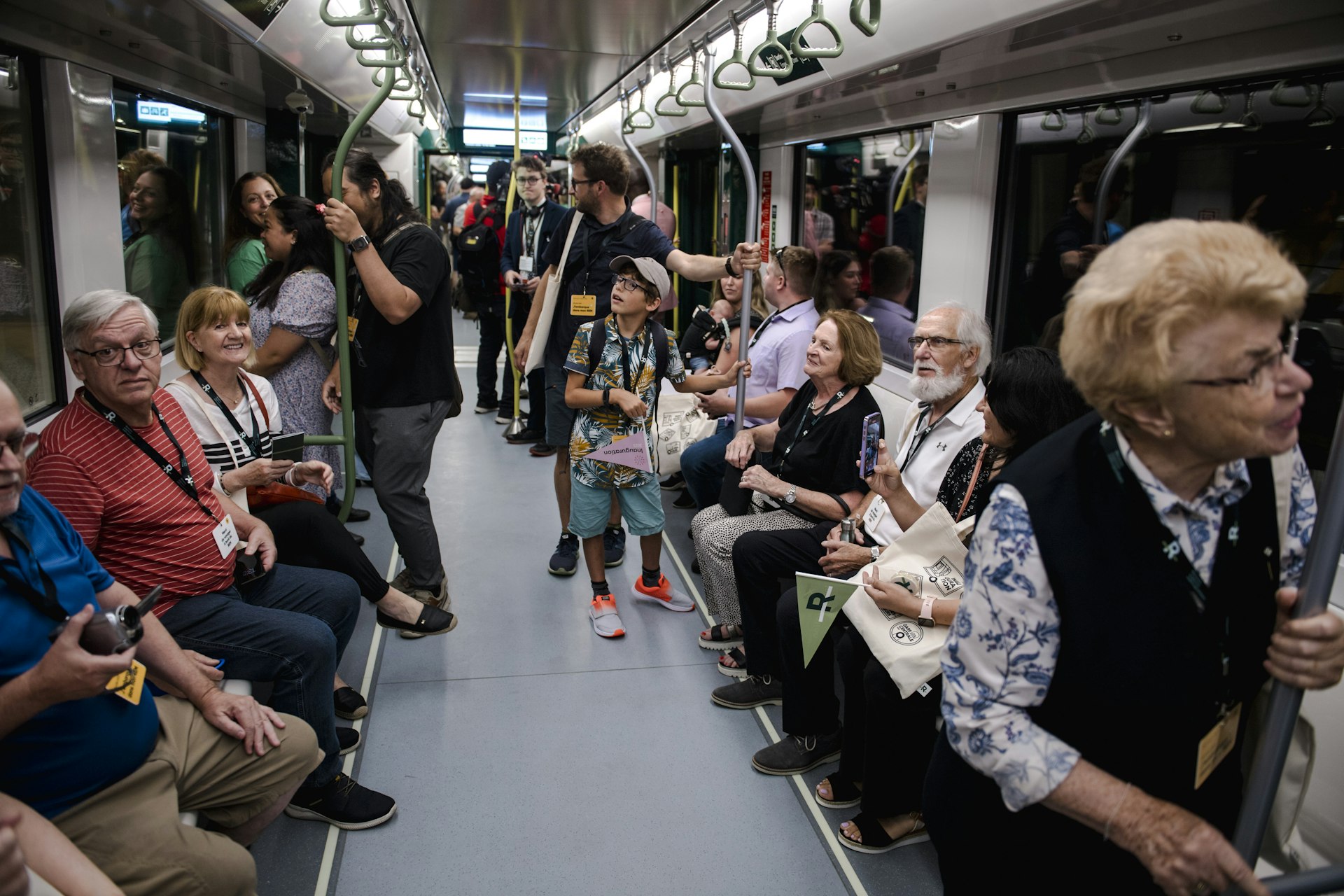
Montréal’s metro and buses make up Canada’s busiest rapid-transit system.
The whole network is operated by Société de Transport Montréal (Montréal Society of Transportation) – commonly known as STM – and it generally does an admirable job of moving Montréalers about safely and efficiently.
Apart from those shiny blue metro cars and widespread buses, Montréal also has a great bike-sharing network as well as trains that can take you out to the suburbs and beyond. Here are some of the best ways to get around Montréal.
 Four lines connect 68 metro stations throughout greater Montréal © Kiev.Victor / Shutterstock
Four lines connect 68 metro stations throughout greater Montréal © Kiev.Victor / Shutterstock
Get there faster by metro
Montréal has an extensive metro network, with four numbered, color-coded lines connecting 68 stations. The service runs entirely underground – a blessing when the wintry winds are howling outside. In general, the metro has a reliable reputation and provides a speedy means of getting around the city. Unlike most other underground networks in North America, Montréal’s rolling stock runs on rubber tires, an obvious French influence (Paris pioneered this technology back in the 1950s) that boosters say is quieter and allows faster acceleration.
The orange ligne deux (line 2) is the most useful line for visitors, as it connects Old Montréal with both downtown and key neighborhoods to the north: the Quartier Latin, the Plateau, Mile End and Little Italy. While each line has slightly different hours, they all generally run from 5:30am to about half past midnight on Sunday through Thursday, continuing around 30 minutes later on Friday and Saturday nights.
Take the bus for better views of city neighborhoods
STM is also responsible for Montréal’s bus network, which fills in the gaps between metro stations with 200-plus lines that crisscross the city. Since metro stations can sometimes leave you a long walk from your ultimate destination, Montréalers mix and match as needed since transfers between the two networks are free. Late at night, the bus may be your only means of getting around apart from taking a pricier taxi or Uber. Around two dozen all-night bus routes operate.
 It’s easy to connect between the metro and the bus – getting you exactly where you need to go in Montréal © Getty Images
It’s easy to connect between the metro and the bus – getting you exactly where you need to go in Montréal © Getty Images
Get the essential OPUS card to take mass transit for less
Montréal’s integrated transit network makes moving between metro and bus a breeze. Fares are determined by zone, with zone A covering all of Montréal. A single bus or metro ticket costs CA$3.75, and allows transfers between bus and metro for up to 120 minutes of the first trip. Two-ride tickets ($7) are also available in metro stations as well as in pharmacies and dépanneurs (delis). On the bus, you can also pay in cash, but no change is available.
If you’re staying in Montréal for more than a few days, you can save money by buying a rechargeable OPUS card. The card costs $6 upfront, but can be recharged at a discounted rate for 10 rides ($32.50), 24 hours of unlimited rides ($11) or three consecutive days ($21.25). You can also buy a one-week ($30) pass – but keep in mind that the passes begin on Monday and end on Sunday, making them a less-than-ideal choice if purchased mid-week.
 Whether on a shared Bixi bike or your own two wheels, cycling in Montréal is a delight © Getty Images
Whether on a shared Bixi bike or your own two wheels, cycling in Montréal is a delight © Getty Images
Enjoy the fresh air and a bit of exercise on a Bixi bike
Launched in 2014, Montréal’s bike-sharing network has since grown in leaps and bounds. At some 865 docking stations, more than 10,000 bikes (including over 3500 electric ones) available for quick jaunts around the city.
Before hopping into the saddle, you’re probably wondering if Montréal is bike-friendly. The answer? Bien sûr! (Of course!) With over 435 miles of bike paths, including traffic-separated express lanes, Montréal is a leader in the urban-cycling world, and has been ranked by various organizations (including the Copenhagen Design Index) as one of the most bikeable big cities in North America. If you come in the winter, however, you’ll find Bixi in hibernation: the cycles are only available from mid-April to mid-November, since snow piles often cover bike lanes in winter, making cycling dangerous.
Download the official Bixi app to find stations nearby and to rent a bike through the app (allowing you to scan a QR code of your chosen bike to unlock it). If you don’t have your phone handy, you can also buy a one-way pass with a credit card and get a five-digit unlocking code to retrieve a bike. If you plan to ride more than a few times, you’ll save money by purchasing a $20 monthly membership (via the app), which gives unlimited 45-minute rides on regular bikes. For non-members, the one-way pass costs $1.25 to unlock the bike, plus 15¢ a minute for regular bikes (30¢ per minute for e-bikes).
Take the train to get out of town
Exo (also known as RTM) operates Montréal’s commuter-train network. Five rail lines link the city center with suburbs stretching north, south, east and west. While not often used by first-time visitors to Montréal, these trains offer the chance to get off the beaten path and visit places like the First Nations reserve of Kahnawake, and the city of Saint-Jérôme, gateway to adventures in the Laurentian Mountains.
Canada’s excellent long-distance network, Via Rail, can take you even farther. Trains from Gare Centrale in downtown make the journey to Québec City in a little over three hours. You can keep going all the way to Halifax (22 hours) or head the other way toward Ottawa (two hours) and on to Toronto (five hours).
 Montréal is working to make its transit system accessible to all passengers © Andrej Ivanov / Bloomberg via Getty Images
Montréal is working to make its transit system accessible to all passengers © Andrej Ivanov / Bloomberg via Getty Images
Accessible travel in Montréal
The city has ambitious plans when it comes to improving the accessibility its public-transport network. STM has invested heavily in renovating its metro stations with the ultimate goal of making all 68 universally accessible. Unfortunately, there’s a lot of work still to be done. Only 20 stations currently are accessible from street to platform, with another 11 stations under renovation and due for reopening by 2025.
Even though the work is incomplete, the stations that are accessible tend to be of great benefit to travelers, including Place d’Armes in Old Montréal, Bonaventure in downtown, Mont Royal for the Plateau, Jean-Talon for Little Italy and Viau for Parc Olympique.
The bus is even more useful for travelers with disabilities. All buses are now wheelchair accessible, with the ability to “kneel” and lower ramps (activated by the driver). Not all bus stops are accessible, however. You can get help planning an accessible route by using the STM route planner. Enter the start (origin) and end (destination) points and tick the “wheelchair accessible” option.



